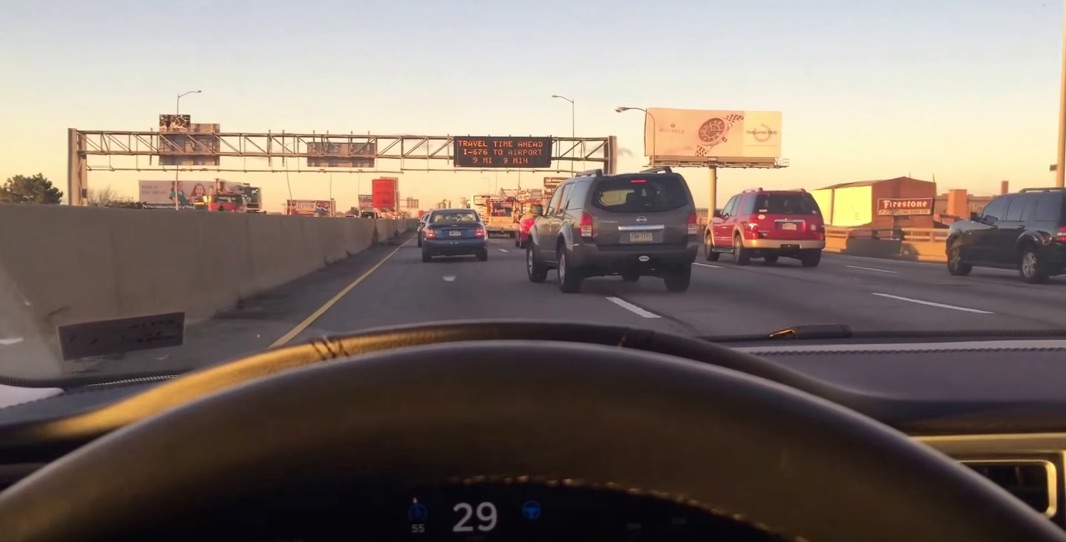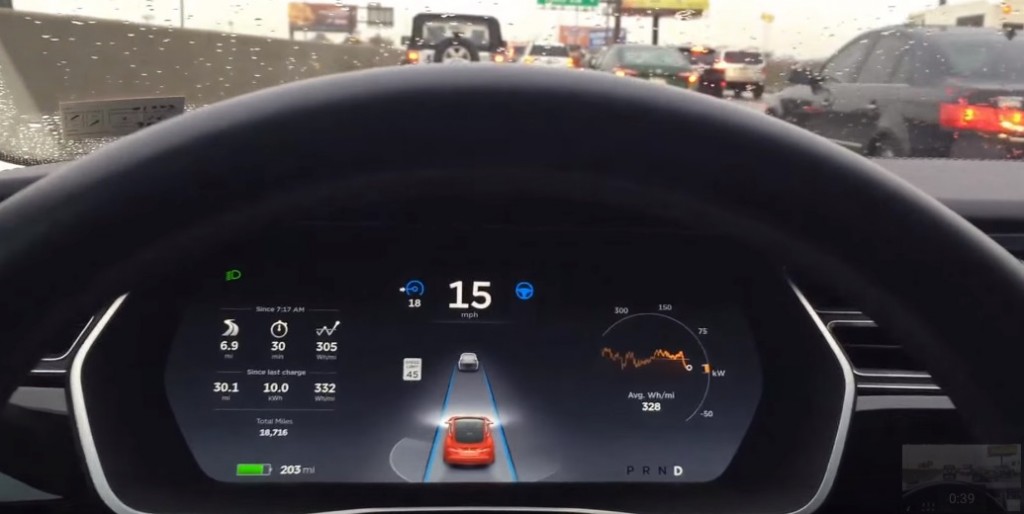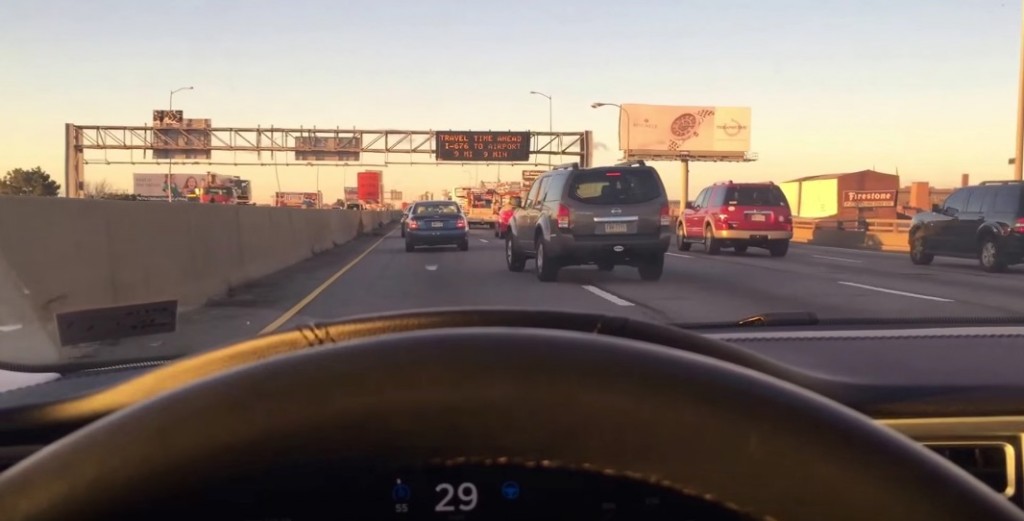As a lucky owner whose Autopilot software update was received at 4:30am on Day 1 of the roll out, I’ve had as much time as anyone to get to know the system and in a nutshell, I can’t see owning a Tesla without it.
Here are the top 5 reasons why I’m addicted to Autopilot:
1. Feedback
This may go without saying, but the Tesla Autopilot System is excellent at giving you feedback to let you know what’s up. I have a basic cruise control feature in my other car and I never use it. I mean never. Given that I use AP nearly every time I’m in the Tesla, I wondered what I hated about my other car’s cruise control, so I attempted to use it recently. I can get over it not being traffic aware and thus only maintaining one speed. What I can’t get over is that I have no idea how to determine when cruise control is engaged. Sure, the word “cruise” shows up when I press a series of confusing buttons to engage but there’s no feedback to tell me when I cancel. I can jam on the brake or take over the accelerator pedal but I have no idea what effect this has on cruise. I pressed the button labeled ‘cancel’ but was still unsure what was going on.
In the Tesla, there is a simple yet clear gray steering wheel symbol to the right of the speedometer that lets you know when the AutoSteer feature is available, and a TACC indicator on the left. A pleasing bright blue is used throughout the displays. In this case, that steering wheel lights blue when AutoSteer is in use. The TACC symbol is simple yet dynamic; showing you what speed it is set to. Blue also plays a role in showing you how the car is controlling itself while engaged in AP driving. Either the road lines light blue to indicate they are being read, or the car ahead of you on the screen lights blue to indicate it is being followed. Blue = on. Gray = available. Got it? Good.
2. It’s Fun
Two words: Pennsylvania Turnpike. Go ahead and insert the most boring and scene-less drive you regularly make. No matter what occasion, time of day, mood or sleep level, driving between Philly and Wilkes-Barre, PA is an instant bore in my mind but Autopilot makes it so much more enjoyable. Call me crazy but open highway driving, despite being responsible for all parts of it, happens automatically for most of us. Staying between painted lines doesn’t require much thought and isn’t at all stimulating. Now you may think that engaging Autopilot would make you even more bored or tired but I’ve found the opposite to be true. You’ve gone from having a monotonous assembly line job to a supervisory one, which activates different thought processes and keeps you interested. Your eyes and mind focus on the lines, the cars around you, and what your own car is doing (or will do) so the drive suddenly becomes a lot less dreadful. Autopilot is no “one trick pony” though, it’s quite good at having the opposite effect on a driver…
3. Relaxation
It wasn’t until I was on the phone with my husband last week while he was driving (hands free of course) that I realized I’m like a slobbering dog when I hear the Autopilot activation chime. He and I were discussing our rather stressful week and when I heard that chime from him activating AP, I was instantly calmed. I firmly believe the Tesla makes all driving better and more relaxing. Despite neck-snapping acceleration, I love driving this car slow and steady. It cradles me safely and luxuriously, and I rarely want my time with it to end. Even so, the ability to enjoy a drive gets tested in any large city’s rush hour traffic. Enter Autopilot, a glorious companion willing to take over some or all of the driving responsibility. Which leads me to…
4. Customization
I’ve written an entire post on this but it bears repeating. You can choose, with very little effort, how much you want the car to do. This is a function of how smart the car is and how quick at processing inputs it is, as well as how easy those inputs are to execute. A little tug of a wheel, tap on the brake or slap of a stalk and you’re changing what you want to do relating to speed, steering, following distance and more. This also includes the ability to use what I’ve heard referred to as “micro corrections.” That is, you can very slightly adjust steering yourself within the lane and without disengaging AutoSteer, which comes in handy when there are concrete barriers or a lack of shoulder in your lane. Plus it gives the system a hint that you’re holding the steering wheel and paying attention.
5. Improvement
This whole entire system came as an update. One day my Tesla had regular cruise control, the next it was traffic aware and thus in my opinion as a former anti-cruise controller, worth using. A few months later, AP as we now know it rolled out and brought us here. Only, there were a ton of tiny improvements in between. Tesla’s fleet learning is revolutionary. We are all more than happy to provide data by using our cars, and Tesla is more than happy to take that knowledge and give it back to us in the form of sometimes imperceptible refinements.
The things I’ve noticed the most are the smoothness of the car’s speed changes and the car’s preference for staying on the highway rather than following a splitting exit lane. Both of these things left much to be desired in early iterations of both TACC and AP but both have gotten infinitely better. It’s sort of a self-fulfilling prophecy. The more you use AP, the more data Tesla gets to make improvements. The more improvements Tesla makes, the more you are willing and wanting to use AP. This is just one of many reasons Tesla’s semi-autonomy is leaps and bound ahead of the competition.
Bonus: Psychedelic Cowbell
For those few Tesla drivers who (begrudgingly so in my case) are considered “millennials,” there is something really magical and even sort of obvious about software updates bringing fun features to the car. After all, we are the generation with smart phones all but surgically implanted in our hands. Forget that though, what I really intend to say is that kids my age grew up playing MarioKart on Nintendo 64 and know the “psychedelic” is really that damned Rainbow Road board that you couldn’t help but fall off of 100 times. Unless you were wimp and chose 50cc engine mode, but friends don’t let friends do such a thing.
For everyone else, it is much more likely you got the “More Cowbell” reference from the Saturday Night Live episode where the phrase was first spoken by Christopher Walken 16 years ago. I doubt many of my fellow 10th grader classmates were watching SNL at that time so I only understood the reference second hand.
All of us can agree though, a company with both the sense of humor and engineering prowess to program and push an Easter egg like this over the air, not 10 days after a random person on Twitter made a joke, is something special. In one single hidden gem like this, there was something for everyone. (And no, the novelty hasn’t worn off yet.)


![Tesla Autopilot Version 7.0 Dashboard Display [Source: Tesla Motors]](http://www.teslarati.com/wp-content/uploads/2015/10/Tesla-Version-7-Autopilot-Dash-1024x384.jpg)











